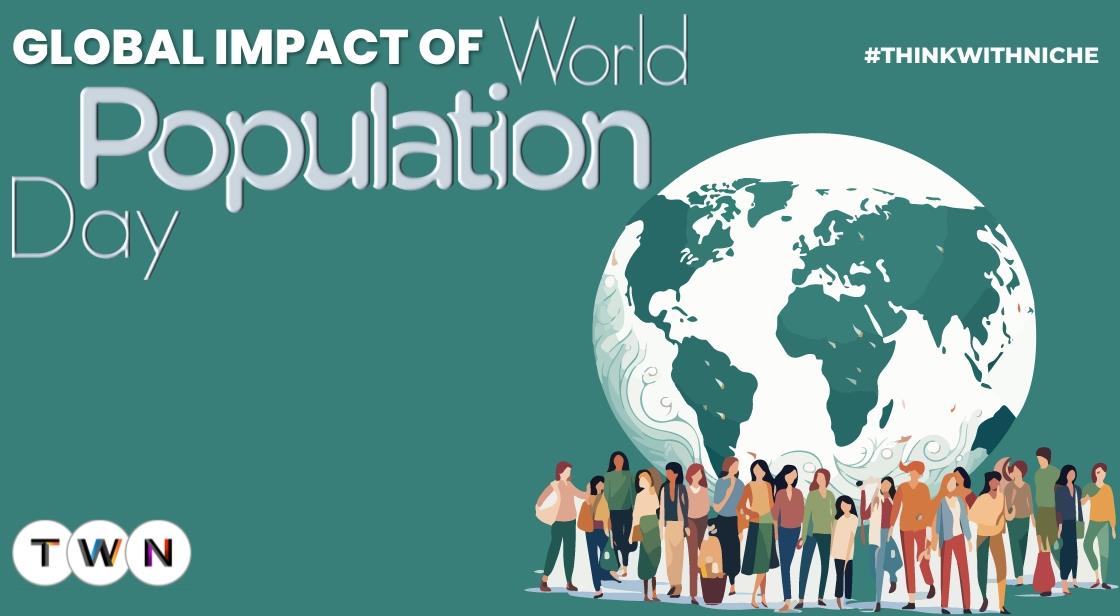Global Impact of World Population Day 2024

Blog Post
As we commemorate World Population Day 2024, the global community converges once again to address pressing issues surrounding population dynamics and sustainable development.
Established by the United Nations, this annual observance on July 11th serves as a pivotal moment to reflect on the intricate interplay between population growth, societal well-being, and environmental sustainability.
It underscores the imperative for informed policies, collaborative actions, and innovative solutions to navigate the challenges and harness the opportunities presented by global demographic shifts.
World Population Day 2024 comes at a critical juncture, amidst a world population approaching 8 billion and projected to reach 9.7 billion by 2050. These demographic changes bring both challenges and opportunities across regions, influencing healthcare systems, economic structures, urban landscapes, and environmental stability.
Understanding these dynamics is essential for shaping inclusive and sustainable development strategies that prioritize equity, resilience, and prosperity for all.
This article explores the significance of World Population Day, highlighting its themes, global observance, and the pivotal role of international collaboration in addressing complex population-related challenges.
It delves into current global population trends, future outlooks, and actionable insights for fostering a sustainable future. By examining successful initiatives and emerging strategies from around the world, we aim to illuminate pathways towards achieving population stability, promoting social equity, and safeguarding our planet's resources for future generations.
Join us in exploring the global impact of World Population Day 2024 and its implications for shaping a sustainable and inclusive world.
World Population Day 2024: Promoting Sustainable Development
Introduction to World Population Day
World Population Day, observed annually on July 11th, aims to raise awareness about global population issues. Established by the United Nations in 1989, this day serves to highlight the importance of population issues in the context of development and global sustainability.
Significance of World Population Day Globally
Celebrated annually on July 11th, World Population Day serves as a critical reminder of the intricate link between population growth and a multitude of global challenges. Established by the United Nations in 1989, this day raises awareness about the need for informed policies and programs to address issues related to:
-
Population Growth: The global population is projected to reach 9.7 billion by 2050 according to the United Nations Department of Economic and Social Affairs (UN DESA). This rapid growth can strain resources like food, water, and energy, impacting the environment and human well-being.
-
Reproductive Health: Ensuring access to safe and effective family planning services empowers individuals to make informed choices about their reproductive health. This includes access to contraception, prenatal care, and skilled birth attendance, all of which are crucial for reducing maternal mortality and improving child health outcomes.
-
Gender Equality: When women have access to education, healthcare, and economic opportunities, fertility rates tend to decline. Empowering women also strengthens families and communities, leading to a more prosperous and equitable future.
-
Poverty Alleviation: Population growth can exacerbate poverty, especially in developing countries. Investing in education, healthcare, and economic development is essential to break the cycle of poverty and ensure inclusive growth.
-
Sustainable Development: Achieving the UN's Sustainable Development Goals (SDGs) requires addressing population dynamics. This includes ensuring sustainable consumption patterns, promoting responsible resource management, and building resilient communities that can withstand environmental pressures.
Beyond Awareness: A Call to Action
World Population Day is not just about raising awareness. It is a call to action for governments, civil society organizations, and individuals to work together to create a more sustainable and equitable future for all. Here are some key ways to address population-related challenges:
-
Investing in Family Planning Services: Increased access to family planning can empower individuals to have the number of children they desire, leading to slower population growth and improved maternal health outcomes.
-
Empowering Women and Girls: Education and economic opportunities for women and girls are critical drivers of population stabilization and overall development.
-
Promoting Sustainability: Sustainable development practices like resource conservation and renewable energy production are essential for meeting the needs of a growing population without compromising the environment.
By working together and implementing effective policies, we can turn the challenges of population growth into opportunities for building a more sustainable and prosperous world for all.
Also Read: Sustainability Strategies for Businesses: Tips for Going Green
Theme or Focus of World Population Day 2024
The theme for World Population Day 2024, "Leave No One Behind, Count Everyone," highlights an often overlooked aspect of population censuses: the comprehensive and inclusive process of gathering data. This theme emphasizes the importance of ensuring that every individual is accurately represented in census data, irrespective of their background, nationality, location, or socioeconomic status.
Importance of the World Population Day 2024 Theme
The theme of World Population Day 2024 will likely highlight critical issues affecting global populations. It may emphasize innovative approaches, strategies, or interventions aimed at addressing challenges such as population growth, reproductive health services, maternal health, youth empowerment, or environmental sustainability.
Global Observance and Participation
World Population Day is observed globally through events, campaigns, workshops, and advocacy efforts organized by governments, NGOs, and civil society organizations. These activities raise awareness, educate communities, and mobilize support for population-related issues.
Current Global Population Trends
Understanding these global population trends is crucial for policymakers, planners, and organizations to develop sustainable strategies for healthcare, education, employment, and social welfare in the coming decades. Addressing these demographic shifts requires collaborative efforts at local, national, and international levels to ensure equitable and inclusive development for all populations.
Overview of Global Population Trends
The world's population is currently estimated to be around 7.9 billion and continues to grow at a significant rate, albeit at a slower pace compared to previous decades. This growth is influenced by various factors including birth rates, life expectancy, and migration patterns.
Population Growth
Global population growth has slowed down in recent years but remains substantial. As of now, the world population is increasing by approximately 80 million people annually. Projections suggest that by 2050, the global population could reach around 9.7 billion. The growth rate varies significantly across regions, with faster growth observed in developing countries compared to developed ones.
Aging Populations
A notable demographic trend is the aging of populations worldwide. Improved healthcare and declining birth rates have led to an increasing proportion of elderly people globally. By 2050, it is estimated that one in six people will be over the age of 65, posing challenges related to healthcare, pensions, and social services in many countries.
Regional Demographic Shifts
Regional demographic shifts highlight diverse trends across continents and countries:
-
Africa: Experiencing rapid population growth with a high proportion of young people.
-
Asia: Home to the largest share of the global population, with varying rates of population growth and aging.
-
Europe: Facing population decline and aging, with implications for workforce and social welfare systems.
-
Latin America: Seeing moderate population growth and aging trends similar to Asia.
-
North America: Stable population growth with aging populations in certain regions.
Projections and Implications
Population projections indicate significant challenges and opportunities:
-
Challenges: Strains on resources, infrastructure, healthcare systems, and social services due to population growth and aging.
-
Opportunities: Potential demographic dividends in regions with youthful populations, contributing to economic growth and innovation.
Challenges Addressed on World Population Day 2024
World Population Day 2024 focuses on addressing critical global challenges that impact sustainable development and societal well-being. Here are the key issues highlighted:
Sustainable Development
Sustainable development remains a paramount challenge as global population growth strains finite resources and exacerbates environmental degradation. On World Population Day 2024, efforts are directed towards promoting sustainable practices in consumption, production, and urban planning to ensure future generations can thrive.
Reproductive Health
Access to reproductive health services and rights is crucial for individuals and communities worldwide. World Population Day 2024 emphasizes the importance of comprehensive reproductive health education, family planning services, and access to contraceptives to empower individuals, particularly women and girls, to make informed choices about their health and future.
Gender Equality
Gender inequality persists globally, affecting access to education, economic opportunities, and healthcare, among other areas. On this day, initiatives focus on promoting gender equality, including addressing barriers that limit women's participation in decision-making processes and ensuring equal access to resources and opportunities for all genders.
Poverty Alleviation
Population growth often intersects with poverty, exacerbating inequalities and limiting economic opportunities for vulnerable populations. World Population Day 2024 highlights strategies for poverty alleviation, such as improving access to education, healthcare, and sustainable livelihoods, to break the cycle of poverty and create inclusive societies.
Environmental Sustainability
The environmental impact of population growth is significant, with increased consumption, waste generation, and habitat destruction threatening biodiversity and exacerbating climate change. Efforts on this day aim to raise awareness about the importance of environmental sustainability, including conservation practices, renewable energy adoption, and mitigating human impact on ecosystems.
Initiatives and Activities on World Population Day 2024
Government Initiatives
Governments worldwide organize various initiatives on World Population Day 2024 to address population-related challenges. This includes:
-
Policy Discussions: Governments convene policy forums and discussions to address population growth, reproductive health, and sustainable development.
-
Public Awareness Campaigns: Launching national campaigns to educate the public on family planning, reproductive rights, and demographic trends.
-
Healthcare Services: Increasing access to reproductive healthcare services, including family planning clinics and maternal health programs.
NGO Efforts
Non-governmental organizations (NGOs) play a crucial role in organizing activities:
-
Community Outreach: NGOs conduct outreach programs in underserved communities, providing information on reproductive health, contraception, and family planning.
-
Advocacy Campaigns: Launching advocacy campaigns to promote gender equality, reproductive rights, and access to education for girls and women.
-
Capacity Building: Providing training and capacity-building programs for healthcare providers and community workers on population-related issues.
International Organizations' Campaigns
International organizations lead global campaigns and initiatives:
-
Global Summits and Conferences: Organizing international conferences and summits to discuss population trends, sustainable development goals (SDGs), and global health.
-
Data Collection and Analysis: Conducting research and data collection on global population trends, demographic shifts, and their implications.
-
Partnerships and Collaborations: Forming partnerships with governments, NGOs, and other stakeholders to implement population-focused programs and initiatives.
Educational Programs
Educational institutions and academic organizations contribute to awareness and research:
-
Research and Publications: Publishing studies and reports on population dynamics, fertility rates, and migration patterns.
-
Student Engagements: Engaging students through seminars, workshops, and projects focused on population studies and sustainable development.
Community Events
Communities participate in local events and activities:
-
Workshops and Seminars: Hosting workshops and seminars on family planning, reproductive health, and sustainable living.
-
Cultural and Artistic Events: Organizing cultural events, art exhibitions, and performances to raise awareness about population-related issues.
Impact on Global Policies and Development Agendas
World Population Day 2024 serves as a catalyst for influencing global policies and development agendas, addressing critical population-related challenges through various initiatives and commitments.
Increased Awareness and Advocacy
World Population Day raises awareness about population issues such as sustainable development, reproductive health, gender equality, poverty alleviation, and environmental sustainability. This heightened awareness often leads to increased advocacy efforts by governments, NGOs, and international organizations to prioritize these issues on global agendas.
Policy Changes and Commitments
In response to the challenges highlighted on World Population Day, governments and international bodies often make significant policy changes, commitments, or resolutions. For instance, countries may pledge to invest more in family planning services, improve maternal and child health care, or enact laws promoting gender equality and reproductive rights.
Funding Allocations
World Population Day can also influence funding allocations towards population-related programs and initiatives. International bodies like the United Nations may allocate more resources to support countries in achieving their population goals, including reducing fertility rates, improving healthcare access, and addressing demographic shifts.
Integration into Development Goals
The discussions and initiatives on World Population Day often feed into broader development frameworks and goals, such as the Sustainable Development Goals (SDGs). Governments and international organizations may integrate population-related targets and indicators into their development plans, ensuring comprehensive strategies for sustainable development.
International Collaboration
World Population Day fosters international collaboration and partnerships among countries, organizations, and stakeholders. It encourages sharing best practices, exchanging knowledge, and coordinating efforts to tackle global population challenges effectively.
Monitoring and Evaluation
Following World Population Day, there is often a focus on monitoring progress and evaluating the impact of policies and initiatives implemented. This helps in assessing the effectiveness of interventions and making necessary adjustments to achieve desired outcomes.
Success Stories and Case Studies
Family Planning Initiatives in Sub-Saharan Africa
In Sub-Saharan Africa, several countries have made significant strides in population management through family planning initiatives. Rwanda and Ethiopia, for example, have implemented successful programs that provide comprehensive family planning services to their citizens.
These programs have empowered women by giving them control over their reproductive health, leading to reduced maternal and child mortality rates. The innovative approaches include community-based distribution of contraceptives and integrating family planning services with maternal and child health programs.
These strategies have not only improved health outcomes but also contributed to economic development by enabling women to participate more fully in the workforce.
Urban Sustainability in Curitiba, Brazil
Curitiba, Brazil, is renowned for its innovative urban planning strategies that promote sustainability while managing population growth. The city’s Bus Rapid Transit (BRT) system is a model of efficient and eco-friendly public transportation, reducing traffic congestion and pollution.
Additionally, Curitiba has implemented extensive recycling programs and created numerous green spaces, integrating parks and natural areas into the urban landscape. These initiatives have significantly improved the quality of life for its residents and set a benchmark for sustainable urban development worldwide.
Education and Health Initiatives in Bangladesh
Bangladesh has made remarkable progress in stabilizing its population through improvements in education and healthcare. Initiatives such as microfinance programs for women, community health worker programs, and educational campaigns promoting girls' education have been pivotal.
These strategies have led to increased literacy rates, reduced fertility rates, and improved health outcomes. By empowering women and ensuring access to essential services, Bangladesh has created a more resilient and equitable society.
Sustainable Agriculture in Vietnam
Vietnam’s approach to sustainable agriculture has played a crucial role in supporting food security and rural development. The country has adopted integrated farming systems, effective water management techniques, and comprehensive farmer training programs on sustainable practices.
These innovations have led to increased agricultural productivity, reduced environmental degradation, and enhanced livelihoods for rural communities. Vietnam’s success demonstrates the potential of sustainable agriculture to address population pressures and promote economic stability.
Coastal Resource Management in the Philippines
In the Philippines, community-led efforts in coastal resource management have yielded positive results. Initiatives such as establishing marine protected areas, implementing community-based fisheries management, and promoting eco-tourism have preserved marine ecosystems while supporting local livelihoods.
These strategies have not only conserved biodiversity but also provided sustainable income sources for coastal communities, showcasing a successful balance between environmental conservation and economic development.
Future Challenges in Global Population Trends
Population Growth and Aging
-
Population Growth: Continued population growth, especially in developing regions, will strain resources and infrastructure.
-
Aging Population: Aging populations in many countries pose challenges for healthcare systems and social security.
Urbanization and Migration
-
Urbanization: Rapid urbanization leads to challenges such as housing, transportation, and sanitation.
-
Migration: Migration trends, including urban-to-rural and international migration, impact demographics and social cohesion.
Environmental Impact
-
Resource Scarcity: Population growth exacerbates resource scarcity, affecting food, water, and energy security.
-
Climate Change: Population dynamics influence climate change mitigation and adaptation strategies.
Opportunities for Future Action
Sustainable Development Goals (SDGs)
-
Implementation: Aligning population policies with SDGs can promote inclusive growth and sustainable practices.
-
Education and Health: Investing in education and healthcare improves population outcomes and economic development.
Technology and Innovation
-
Digital Solutions: Technology can enhance healthcare delivery, education access, and resource management.
-
Green Technologies: Innovations in renewable energy and sustainable agriculture support population and environmental goals.
International Cooperation
-
Global Partnerships: Collaborative efforts among countries and organizations can address cross-border population challenges.
-
Policy Harmonization: Aligning policies on migration, healthcare, and environmental protection fosters global stability and resilience.
Conclusion
World Population Day 2024 serves as a pivotal moment to reflect on the global challenges and opportunities related to population dynamics. As we navigate the complexities of a world with nearly 8 billion inhabitants, the need for strategic action and collaboration across borders becomes increasingly apparent.
The initiatives and discussions on this day underscore the interconnectedness of population issues with sustainable development goals, reproductive health rights, gender equality, poverty alleviation, and environmental sustainability. By addressing these interlinked challenges, we can pave the way for a more equitable and resilient future for all.
You May Like
EDITOR’S CHOICE












